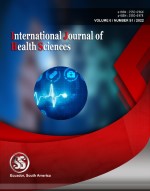Assessment of the surgical outcomes of esotropia in pediatric subjects with high accommodative convergence/accommodation ratio
A clinical assessment
Keywords:
Esotropia, bilateral medial rectus recession, high AC/A ratio, target angle, strabismus surgeryAbstract
Background: Treating subjects with a high AC/A ratio and with esotropia is a challenging and complex procedure, often associated with increased near deviation which may lead to various outcomes following the surgery. Aims: The present study was conducted to assess outcomes following surgery in children with esotropia who were surgically treated with primary bilateral medial rectus (BMR) recessions. The study also compared preoperative and postoperative measurements in subjects with a high AC/A ratio to a normal AC/A ratio to assess surgical outcomes. Materials and Methods: 122 subjects were divided into 2 groups based on AC/A ratio into high AC/A ratio and normal AC/A ratio The subjects with high AC/A were treated with bifocal management if they had near persistent ET of ≥10Δ in full cycloplegic correction and not if they had far ET of ≥10Δ. Target angle at the time of the surgery was assessed with stereopsis presence via positive butterfly/fly, and near and distance deviations ≤10Δ within orthophoria. These success outcomes were compared in subjects with normal AC/A ratio and AC/A ratio groups. The collected data were subjected to statistical evaluation.
Downloads
References
Hesgaard HB, Wright KW. Principles of Strabismus Surgery for Common Horizontal and Vertical Strabismus Types. Advances in Eye Surgery 2016:249.
Spierer O, Spierer A. Unilateral lateral rectus recession is an effective surgery for intermittent exotropia in young children. BMC Ophthalmol. 2021;21:10.
Chatzistefanou KI, Mills MD. The role of drug treatment in children with strabismus and amblyopia. Paediatr Drugs. 2000;2:91–100.
W.K. Kim, S.Y. Kang, S. Rhiu, S.A. Chung, J.B. Lee. The analysis of AC/A ratio in nonrefractive accommodative esotropia treated with bifocal glasses. Korean Journal of Ophthalmology. 2012;26:39-44.
Kekunnaya R, Chandrasekharan A, Sachdeva V. Management of strabismus in myopes. Middle East Afr J Ophthalmol. 2015;22:298–306.
Kushner BJ. The fifteen-year outcome of surgery for the near angle in patients with accommodative esotropia and a high accommodative convergence to accommodation ratio. Arch Ophthalmol 2001;119:1150 3.
Çerman E, Eraslan M, Ögüt MS. The relationship of age when motor alignment is achieved and the subsequent development of stereopsis in infantile esotropia. J AAPOS 2014;18:222 5.
Lueder GT, Norman AA. Strabismus surgery for elimination of bifocals in accommodative esotropia. Am J Ophthalmol 2006;142:632-5.
Li B, Sharan S. Postoperative analysis of pediatric esotropia associated with high hypermetropia. BMCOphthalmol 2019;19:140.
Park KA, Oh SY. Esotropia with an accommodative component after surgery for infantile esotropia compared to primary accommodative esotropia. J AAPOS 2017;21:9 14.
TejedorJ,Gutiérrez CarmonaFJ.Amblyopia in high accommodative convergence/accommodation ratio accommodative esotropia. Influence of bifocals on treatment outcome. Am J Ophthalmol 2018;191:124 8.
Published
How to Cite
Issue
Section
Copyright (c) 2022 International journal of health sciences

This work is licensed under a Creative Commons Attribution-NonCommercial-NoDerivatives 4.0 International License.
Articles published in the International Journal of Health Sciences (IJHS) are available under Creative Commons Attribution Non-Commercial No Derivatives Licence (CC BY-NC-ND 4.0). Authors retain copyright in their work and grant IJHS right of first publication under CC BY-NC-ND 4.0. Users have the right to read, download, copy, distribute, print, search, or link to the full texts of articles in this journal, and to use them for any other lawful purpose.
Articles published in IJHS can be copied, communicated and shared in their published form for non-commercial purposes provided full attribution is given to the author and the journal. Authors are able to enter into separate, additional contractual arrangements for the non-exclusive distribution of the journal's published version of the work (e.g., post it to an institutional repository or publish it in a book), with an acknowledgment of its initial publication in this journal.
This copyright notice applies to articles published in IJHS volumes 4 onwards. Please read about the copyright notices for previous volumes under Journal History.
















